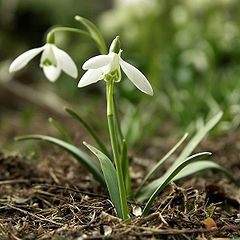clade of flowering plants (in APG I-III) From Wikipedia, the free encyclopedia
Flowering plants are plants that bear flowers and fruits. Most land plants today are flowering plants (Angiosperm or Magnoliophyta).
| Angiospermae Temporal range: Lower Cretaceous – Recent | |
|---|---|
 | |
| Snowdrop | |
| Scientific classification | |
| Kingdom: | |
| Subkingdom: | |
| Division: | Angiospermae |
| Classes | |
|
Traditional groups: | |

Together with the gymnosperms they make up the seed plants. They differ from the gymnosperms in that angiosperms have flowers, and have enclosed ovules. Gymnosperms have naked seeds on cones or open structures.

Angiosperms have a number of derived characters, which evolved as they split off from the gymnosperms.
Flowers, the reproductive organs of flowering plants, are the most remarkable feature distinguishing them from other seed plants. Flowers, with their colour and their nectar, attract pollinators, which are mostly insects and birds. 95% of flowering plants in tropical lowlands rely on animals for pollination or dispersal of seeds.[1] Although in general, this is true, it is not true of one great group of angiosperms: the grasses. The reason is not clear, but grasses dominate several of the largest land areas: in North America, Asia, and in Africa. They are all wind-pollinated.
Gymnosperms were and are almost entirely wind-pollinated, but early flowers were probably all insect-pollinated.[2] Some present-day flowering plants are wind-pollinated, but that is a secondary feature.[3]p182
The fertilized angiosperm ovule develops into a seed, and the ovary develops into the fruit. The fruit is often a way to use animals to spread the seeds far and wide. The fruit is made out of the carpel and some tissue around it. The carpel carries structures called ovules, inside which egg cells form.
In general, endosperms form after fertilization and before the first division of the zygote. Endosperm is a highly nutritive tissue that can provide food for the developing embryo, the cotyledons, and sometimes the seedling when it first appears.
Specialized sexual parts have led to co-evolution in fertilization and seed dispersal. The stamens, and the male and female gametophytes, have been adapted in many ways to suit particular pollinators. The smaller pollen grain shortens the time between pollination and fertilization, which can be up to a year in gymnosperms. The small female gametophyte also allows rapid seed production, which led to annual herbaceous life-cycles.
Adaptations in these novelties allowed angiosperms to invade many habitats. They now dominate everywhere except the boreal forest or taiga, which is still composed almost entirely of gymnosperms, usually pines.
Molecular evidence indicates that the ancestors of angiosperms diverged from the gymnosperms during the late Devonian, about 365 million years ago. They did not appear in the fossil record until the Mesozoic, almost two hundred million years later.[4][5]
A whole genome duplication (doubling) at 160 million years ago (mya) may have started the ancestral line that led to all modern flowering plants.[6] That event was studied by sequencing the genome of an ancient flowering plant, Amborella trichopoda.[7] Amborella, found on the Pacific island of New Caledonia, belongs to a sister group of the other flowering plants. Studies suggest that it has features that may have been characteristic of the earliest flowering plants.[8]
The earliest known fossil confidently identified as an angiosperm, Archaefructus liaoningensis, is dated to about 125 mya in the Lower Cretaceous.[9] Pollen probably of angiosperm origin takes the fossil record back to about 130 mya.
There are still some examples of Cretaceous angiosperms in the Daintree Rainforest: twelve primitive angiosperms (flowering plant) families: Cunoniaceae, Proteaceae (banksia and macadamia family), Winteraceae, Myrtaceae (eucalypt and Syzygium or lilly pilly), Monimiaceae, Rutaceae, Sapindaceae, Aquifoliaceae (holly family), Chloranthaceae, Trimeniaceae, Epacridaceae (heath family), Olacaceae. These families of angiosperms have the longest continuous history with the Gondwanan landmass.
The phylogeny of Angiosperms is as follows: [10][11]
The territory is pretty much covered by three groups: the Magnoliids, the Monocots, and the Eudicots. The Eudicots outnumber all other groups put together. However, grasses are the food of most herbivores today. Their spread in the later Miocene and the associated reduction in forests caused the extinction of most browsers and their replacement by grazers.
Seamless Wikipedia browsing. On steroids.
Every time you click a link to Wikipedia, Wiktionary or Wikiquote in your browser's search results, it will show the modern Wikiwand interface.
Wikiwand extension is a five stars, simple, with minimum permission required to keep your browsing private, safe and transparent.